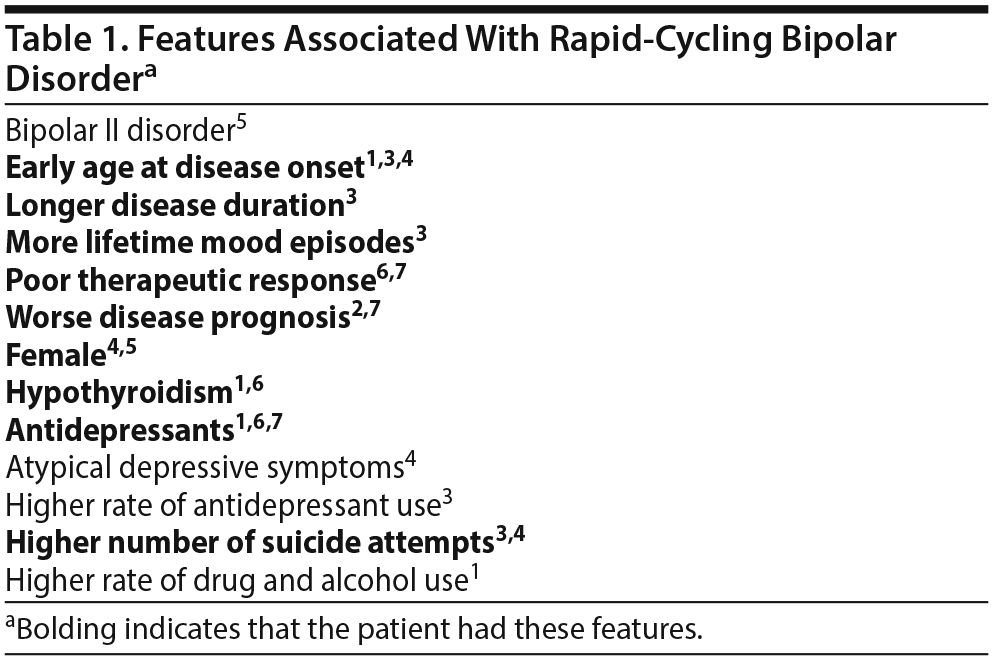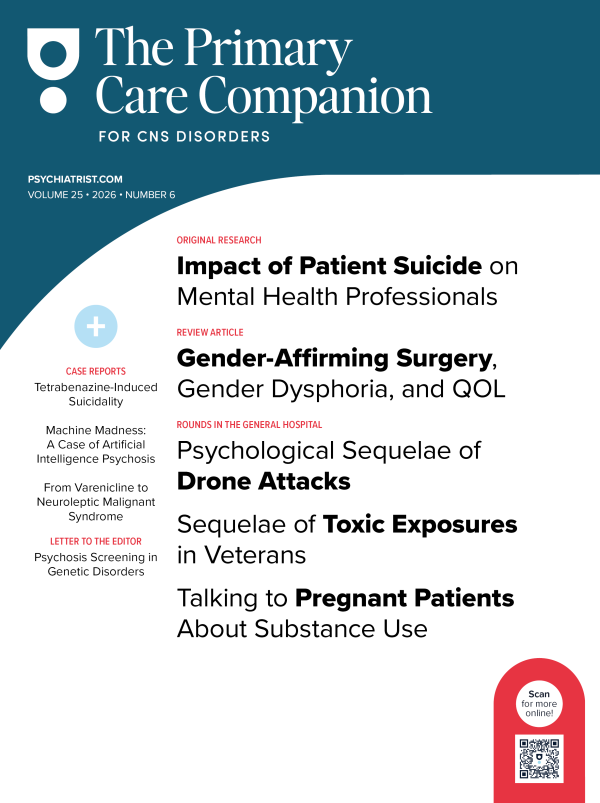Because this piece does not have an abstract, we have provided for your benefit the first 3 sentences of the full text.
To the Editor: Bipolar disorder is a chronic illness characterized by severe and recurrent mood episodes. Rapid cycling is a frequent underrecognized condition in bipolar disorder and is applied to patients with 4 or more mood episodes within a year. Rapid cycling ranges from a 12-month prevalence of 9% to 32% to a lifetime prevalence of 26% to 43%, as it is a transient phenomenon in most bipolar disorder patients, and is often associated with worse disease outcomes and severe disability.
Clinical Features and Longitudinal Prognosis of Ultra-Rapid-Cycling Bipolar Disorder
To the Editor: Bipolar disorder is a chronic illness characterized by severe and recurrent mood episodes. Rapid cycling is a frequent underrecognized condition in bipolar disorder1 and is applied to patients with 4 or more mood episodes within a year.2 Rapid cycling ranges from a 12-month prevalence of 9% to 32% to a lifetime prevalence of 26% to 43%,3 as it is a transient phenomenon in most bipolar disorder patients, and is often associated with worse disease outcomes and severe disability.4 Some patients experience ultra-rapid cycling, defined by very brief cycles lasting for days.4 We report a case of bipolar disorder with ultra-rapid cycling to highlight the importance of early recognition of associated clinical features and a proper therapeutic approach.
Case report. Ms A was a 47-year-old woman diagnosed with bipolar I disorder (DSM-5) at age 30 years, with a total of 36 inpatient admissions, including 5 suicide attempts. The average time between episodes had been so short (hospitalizations required every 1-2 months recently) that the course of the disease had contributed to overall functional impairment, with major instability in most domains of her life. Despite having a higher degree, she had not worked for 15 years and had a pattern of progressively deteriorating interpersonal relationships.
Additionally, she had a personal medical history of hypothyroidism and a significant family history of bipolar disorder. Her mood episodes started at age 16 years with a depressive episode, but psychiatric follow-up only started after her first hospital admission due to a manic episode at age 30 years. Following this episode, frequent and rapid mood cycles ensued, most with psychotic symptoms, along with a pattern of medication nonadherence. This clinical pattern remained unchanged despite numerous pharmacologic and nonpharmacologic therapeutic interventions, which included use of antidepressants in depressive episodes at first admissions.
In March 2017, Ms A was admitted to our inpatient psychiatric unit due to a manic episode with mood, thought, psychomotor, and psychotic symptoms and no insight into her condition. The neuropsychological assessment showed deficits in sustained attention, episodic memory, executive functions, visuospatial processing, and semantic verbal fluency.
Mood-stabilizing therapy was prescribed, but after 12 days of hospitalization, she switched to a depressive episode with significant impact, namely social isolation, clinophilia, and motor inhibition, and the introduction of an antidepressant was necessary. Bupropion 150 mg/d was chosen because of its low potential for inducing hypomanic or manic switches. However, only 3 days after initiation of bupropion, a manic episode ensued, and antidepressant therapy was discontinued. Multiple other mood episodes of opposite polarity occurred during the same hospitalization period and under optimized mood-stabilizing therapy with anticonvulsants and antipsychotics. A mean cycling rate of 9 to 12 days between switches was observed.
After 8 weeks, Ms A was discharged on risperidone long-acting injection 50 mg every 2 weeks, valproic acid 800 mg/d, lamotrigine 150 mg/d, and quetiapine 300 mg/d. She was admitted to a psychosocial rehabilitation program in our day hospital for continued clinical care and vigilance.
Four months later, after the death of a significant family member and subsequent medication discontinuation, she was again admitted to the hospital due to a manic episode. During this hospitalization period, she cycled to yet another depressive episode. After 4 weeks, she was discharged euthymic with regularization of sleep-wake schedules and remission of psychomotor and psychotic symptoms. She maintained executive deficits, a slight thought acceleration, grandiose thinking, and modest insight into her condition. Stabilization was achieved with the following therapeutic regimen: risperidone long-acting injection 50 mg every 2 weeks, oral risperidone 4 mg, valproic acid 1,000 mg/d, lamotrigine 150 mg/d, and quetiapine 400 mg/d.
During follow-up, mood episodes continued to occur, although they were substantially less intense with no significant additional functional impairment compared with past episodes. She had no subsequent admissions. She continues to attend her psychiatric appointments regularly with satisfactory therapeutic compliance.
Development of rapid cycling in bipolar disorder is associated with poorer clinical outcomes. Early recognition of sociodemographic and clinical features related to rapid cycling, several of which are present in this report (marked in bold in Table 1), is essential in clinical management of bipolar disorder. Early onset of symptoms, high number of lifetime mood episodes, absence of a significantly long period of clinical remission, and cognitive deterioration emphasize the burden of rapid cycling.
The literature examining the pharmacologic treatment of rapid cycling is sparse, and there is no clear consensus. Current evidence8 suggests that an effective response may be achieved in acute rapid cycling with atypical antipsychotics. Lithium and anticonvulsants show equivalent but lower clinical response.8
Given that Ms A had already received lithium treatment with recurrent discontinuations, we decided to try the combination of valproic acid and lamotrigine for both mania and depression prevention. Since rapid cycling is related to a pattern of medication nonadherence,9 we initiated treatment with risperidone long-acting injection given that it has been shown to decrease the number of change-in-mood episodes in rapid-cycling patients10 and that long-acting injectable antipsychotics seem to promote medication adherence and lower discontinuation risk among bipolar disorder patients.11 Also, due to the known interaction between valproic acid and lamotrigine,12 it was not possible to titrate these 2 medications to the highest doses, which reinforced the need for adequate risperidone coverage and justified the addition of oral risperidone to risperidone long-acting injection. Disruption of the sleep-wake cycle is a known trigger of mood switches,12 and sleep regularization was only possible with an increased dose of quetiapine.
In conclusion, ultra-rapid cycling can be considered a severe presentation of bipolar disorder, significantly impacting the patient’s daily life and long-term prognosis and requiring complex and demanding treatment strategies. Further investigation is necessary to clarify the appropriate treatment for rapid cycling.
References
1. Carvalho AF, Dimellis D, Gonda X, et al. Rapid cycling in bipolar disorder: a systematic review. J Clin Psychiatry. 2014;75(6):e578-e586. PubMed CrossRef
2. American Psychiatric Association. Diagnostic and Statistical Manual for Mental Disorders. Fifth Edition. Washington, DC: American Psychiatric Association; 2013.
3. Gigante AD, Barenboim IY, Dias RD, et al. Psychiatric and clinical correlates of rapid cycling bipolar disorder: a cross-sectional study. Rev Bras Psiquiatr. 2016;38(4):270-274. PubMed CrossRef
4. Valent× M, Pacchiarotti I, Undurraga J, et al. Risk factors for rapid cycling in bipolar disorder. Bipolar Disord. 2015;17(5):549-559. PubMed CrossRef
5. Erol A, Winham SJ, McElroy SL, et al. Sex differences in the risk of rapid cycling and other indicators of adverse illness course in patients with bipolar I and II disorder. Bipolar Disord. 2015;17(6):670-676. PubMed CrossRef
6. Köhler S, Friedel E, Stamm T. Rapid cycling in bipolar disorders: symptoms, background and treatment recommendations [German]. Fortschr Neurol Psychiatr. 2017;85(4):199-211. PubMed CrossRef
7. Perlis RH, Ostacher MJ, Miklowitz DJ, et al. Clinical features associated with poor pharmacologic adherence in bipolar disorder: results from the STEP-BD study. J Clin Psychiatry. 2010;71(3):296-303. PubMed CrossRef
8. Fountoulakis KN, Kontis D, Gonda X, et al. A systematic review of the evidence on the treatment of rapid cycling bipolar disorder. Bipolar Disord. 2013;15(2):115-137. PubMed CrossRef
9. Greene M, et al. Medication adherence and discontinuation of long-acting injectable versus oral antipsychotics in patients with schizophrenia or bipolar disorder. J Med Econ. 2018;21(2):127-134. PubMed CrossRef
11. Hsieh MH, Chuang PY, Wu CS, et al. Bipolar patients treated with long-acting injectable risperidone in Taiwan: a 1-year mirror-image study using a national claims database. J Affect Disord. 2017;218:327-334. PubMed CrossRef
10. Zaccara G, Perucca E. Interactions between antiepileptic drugs, and between antiepileptic drugs and other drugs. Epileptic Disord. 2014;16(4):409-431. PubMed
12. Abreu T, Bragança M. The bipolarity of light and dark: a review on bipolar disorder and circadian cycles. J Affect Disord. 2015;185:219-229. PubMed CrossRef
aServiço de Psiquiatria e Saúde Mental do Hospital de Santa Maria, Centro Hospitalar Lisboa Norte, Lisbon, Portugal
Potential conflicts of interest: Dr C×¢mara Pestana reports nonfinancial support from Janssen-Cilag Farmacêutica, Lundbeck Portugal—Produtos Farmacêuticos, and Servier Portugal-Especialidades Farmacêuticas. Dr Silva reports nonfinancial support from Janssen-Cilag Farmacêutica, Lundbeck Portugal-Produtos Farmacêuticos, and Servier Portugal-Especialidades Farmacêuticas. Dr Ferreira reports nonfinancial support from Janssen-Cilag Farmacêutica, Lundbeck Portugal-Produtos Farmacêuticos, and Angelini Farmacêutica. Dr Martins reports personal fees from Janssen-Cilag Farmacêutica, Angelini Farmacêutica, and PharSolution Pharmaceutical Consulting.
Funding/support: None.
Previous presentation: None.
Patient consent: Permission was received from the patient to publish the case report, and information has been de-identified to protect anonymity.
Published online: September 6, 2018.
Prim Care Companion CNS Disord 2018;20(5):17l02222
To cite: C×¢mara Pestana P, Silva ID, Ferreira AB, et al. Clinical features and longitudinal prognosis of ultra-rapid-cycling bipolar disorder. Prim Care Companion CNS Disord. 2018;20(5):17l02222.
To share: https://doi.org/10.4088/PCC.17l02222
© Copyright 2018 Physicians Postgraduate Press, Inc.
Please sign in or purchase this PDF for $40.00.



